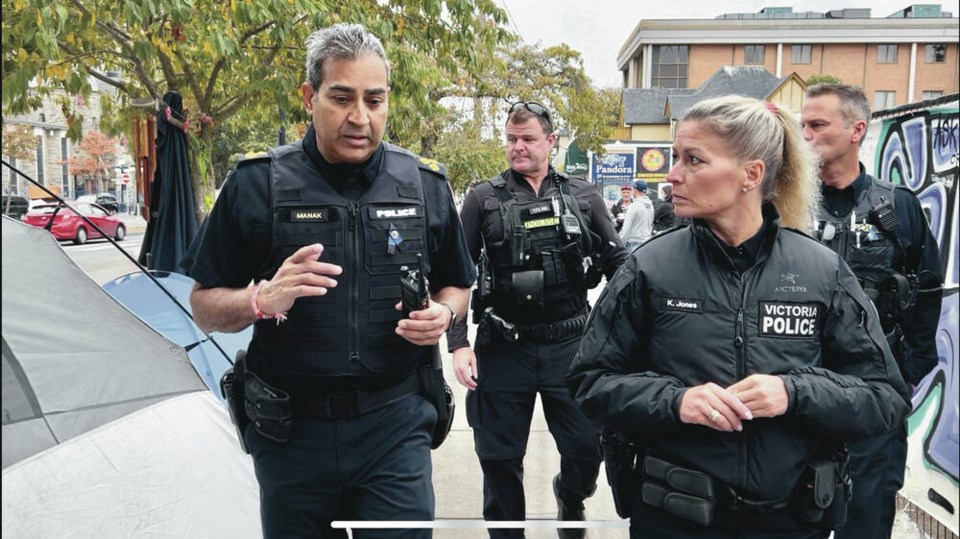The murder of RCMP Const. Shaelyn Yang in a Burnaby park is a “call for action” to deal with significant gaps in mental-health and addiction care, Victoria Police Chief Del Manak says.
Yang, a 31-year-old member of Burnaby’s mental health and homelessness outreach team, was stabbed to death on Tuesday as she and a member of the city’s parks department responded to a call about a tent in a park.
Yang’s line-of-duty death touched all members of the Victoria Police Department, said Manak.
“But as sad and tragic as it is, it does not come as a surprise to us because we see it on our streets every day,” said Manak. “This is the reality. This is the world we live in every day.”
Victoria police will rethink their approach to dealing with people camping in parks and on the Pandora Avenue boulevard, said Manak.
“We’ll reassess how we approach and prioritize safety. Although we don’t know the details of what exactly happened … it’s an opportunity for us to ask questions, review our tactics and make sure we are doing everything we can to prevent a similar incident happening here.”
Victoria police officers have seen a significant shift in the attitude and demeanour of many of the campers, said Manak. Officers are encountering a new level of aggression, non-compliance, hostility and active resistance.
Two police officers are deployed to assist the city’s bylaw officers. Those bylaw officers have been assaulted and chased out of parks.
“We don’t send one officer because sometimes when we’re trying to de-escalate a situation, somebody pops out of another tent or somebody comes up behind. If someone is shouting from a nearby tent and two or three people come up, we have to make sure we maintain presence and control of the situation,” said Manak.
Officers are de-escalating serious situations multiple times every day. They’re also dealing with violence and weapons.
In August, officers found a loaded handgun in an unoccupied tent in Stadacona Park. At Rock Bay landing, a man was stabbed in the chest when he didn’t give someone a cigarette. A forensic identification officer, called out to a stabbing outside Our Place, was attacked in the middle of the night.
Last week, police found an 18-kilogram mace outside a housing facility. Someone had filled a metal ball with concrete, then welded spikes onto it. It had a metal pole attached so it could be swung like a baseball bat.
Everyone is arming themselves, said Manak. There is a real level of fear on the street; people feel they need to protect themselves, he said.
Many of the campers are dealing with severe opioid addiction and severe mental health challenges. They’ve lost the ability to self-regulate and are caught up in cycles of abuse with no ability to break free, the chief said. Many are prone to violence.
Some of the people in parks have been housed and have been evicted, some of them multiple times, said Manak.
“They’ve told us that they don’t feel safe when they are in housing because they’re users. They’re worried about overdosing in an apartment where no one can help them. In a public area, it’s more likely they’ll be saved. They actually feel safer being in a park or being amongst their peers than having a home.”
In addition, people in supportive housing have told police they don’t feel safe. They won’t call police anymore because of the strong street culture that says you don’t talk to police or there will be retribution.
They try to resolve situations themselves or they live in fear. This means many are surviving without any help and they are being exploited, said Manak. “What we’re left with is significant gaps in the mental-health care continuum and addictions care. It’s a real concern.”
Manak went for a walk along Pandora and through Stadacona Park on Thursday morning. His officers pointed to several tents where they had responded to fatal overdoses last week and three weeks ago. There were memorial photos of some posted on a telephone pole. “It’s just shocking. We hope there’s a light at the end of the tunnel, but it honestly is pretty bleak because we’ve been dealing with this for a long time and it becomes challenging,” said Manak. “It’s also demoralizing for police officers working the front line who expect policies and decisions and governments to give them the tools to keep communities safe and keep people safe. Right now, it feels like it’s a free-for-all on the streets.”
Focusing on harm reduction can only go so far, Manak said. Clean drugs and clean needles are important but prevention and treatment are also important. “What are we doing to stop the next person from becoming drug addicted? And the person who is drug addicted — are we just giving them more drugs to support their habit or are we looking at weaning them off to remove them from that cycle of abuse?”
Police assisting bylaw officers wear their uniform and a bullet-proof vest. They have a gun, baton and handcuffs. It’s far more advantageous to have officers in uniform, Manak said. It just speaks to authority, presence and knowing the police are there for a particular role, he said.
>>> To comment on this article, write a letter to the editor: [email protected]



